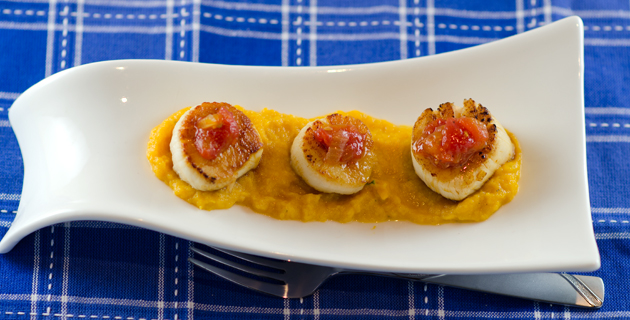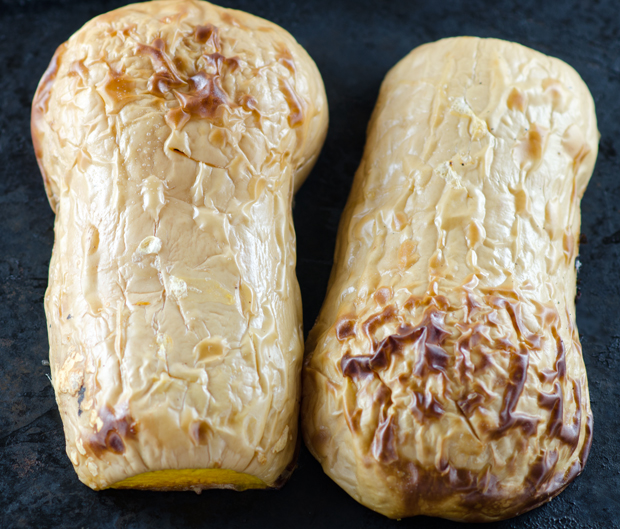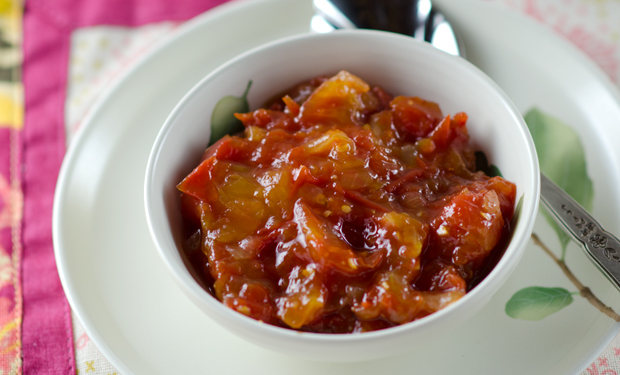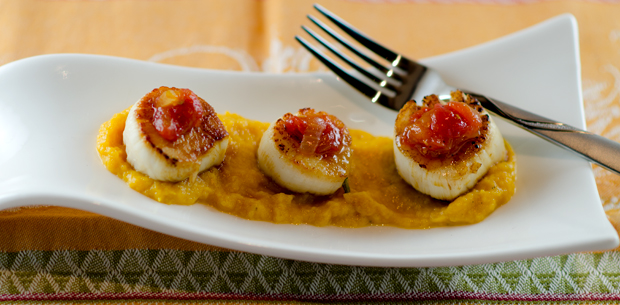“Use us!” they seemed to call out, well not literally, I haven’t lost my mind yet. But every time I passed the small basket of the “last gasp” tomatoes that hung in there until late October I knew I should use them to commemorate the end of the season. Granted these survivors were not salad worthy, though red and ripe looking on the outside, inside they were a bit pale, even white in some sections. Several weeks ago I had torn out a recipe from the food section of the local newspaper that could fill the bill, Barnegat Light Scallops with Butternut Squash Puree and Tomato Jam. I knew I had the four cups of diced tomatoes needed so that’s where they would go.
Barnegat Light, the distinction of the scallops called for in this recipe, is located at the northern end of Long Beach Island, New Jersey. It’s home to “Old Barney” the second tallest lighthouse in the United States. Barnegat Light is one of the top fishing ports in the United States and home to a fleet of scallopers that bring in over 2 milllion pounds a year. This makes New Jersey the country’s second largest producer of scallops a year, just behind Masschusetts.
Whether your scallops have the Barnegat Light distinction or not, always cook with dry scallops. Dry scallops originate from boats that go out, shuck and ice their haul on board and return to shore the same day, hence the name “day boat”. Wet scallops come from boats that are out to sea for many days at a time. To preserve their catch, fishermen have to soak their scallops in a solution of sodium tripolyphosphate (aka STP) before they are frozen. STP causes scallops to soak up water before the freezing process. This plumps up the scallop by as much as 30% and increases the before sale weight and also the price you pay. Wet pack scallops will appear plumper and whiter when placed next to their dry counterparts. When cooked, they will exude all the excess slightly soapy tasting water when cooked and will become shrunken and rubbery before they even get to the carmelization stage.
To achieve perfectly caramelized scallops, first pat the scallops dry with paper towels, excess moisture will impede the browning process. Detach the tough abductor muscle from the side of the scallop with your fingers. Season the scallops lightly with salt and pepper. Heat a heavy bottomed pan over high heat for a minute or two. Add a thin film of flavorless oil (canola is my preference) and place the scallops in the hot pan, making sure not to crowd them. If the scallops are too close they will steam, not sear. Leave the scallops to sear undisturbed for two minutes. With tongs, gently lift one up to see if the desired caramelization has been achieved. Flip the scallops and allow them to cook for another 2 to 3 minutes.
Tis the season for winter squash and they are appearing in abundance at my local farmers market. I just simply cut the squash in half, baked it at 375°F for a half hour. I pureed the squash with a little half and half, a little fresh nutmeg and a sprinkling of sage. Acorn or kabocha squash could easily fill in for the butternut. Cooking them slow and long, I coaxed as much flavor as possible out of my tomatoes. I was quite pleased with the results. Tomato jam would be a good accompaniment to a burger or a grilled cheese sandwich also. The mellow sweetness of the butternut squash complimented the nutty brown crust of the scallops. Inside the scallops were still tender and creamy and the tomato jam added a nice piquancy to the finished dish.
Barnegat Light Scallops with Butternut Squash Puree and Tomato Jam
Ingredients
- 12 medium sized dry pack scallops
- 1 medium butternut squash
- 1/2 to 1 c heavy cream or half and half
- 1/4t rubbed sage
- 1/4t freshly ground nutmeg
- 4c fresh tomatoes, finely diced
- 1 small sweet onion, finely diced
- 1c rice wine vinegar
- 1/2c water
- 1/2c sugar
- Kosher salt and freshly ground pepper
- Canola Oil
Directions
For the squash
- Preheat oven to 375°F. Cut squash in half lengthwise. Place cut side down on a baking sheet.
- Bake squash for about a half hour or until squash is easily pierced with a knife
- Allow the squash to cool slightly. Scoop squash flesh into the bowl of a food processor. Add sage, nutmeg and just enough cream or half and half to make a smooth puree. Transfer puree to a small saucepan and keep warm over low heat, or store until ready to use.
For the tomato jam
- Combine the tomatoes, onion, vinegar, water and sugar in a nonreactive saucepan, this is when I pull out the Le Creuset. Bring to a boil and reduce to a simmer.
- Allow to cook down until thickened, this may vary depending on the water content of the tomatoes. Remove from heat and cool. Season with salt and pepper.
For the scallops
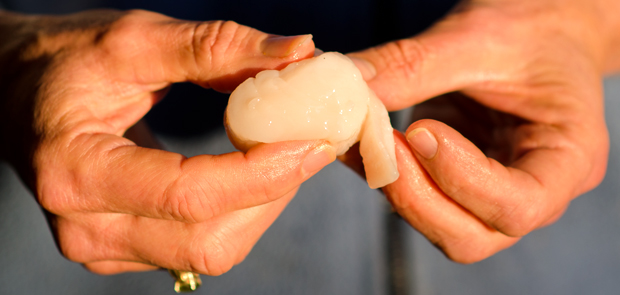
- Remove the small abductor muscle from the side of the scallop. Pat dry with paper towels and season lightly with salt and pepper.
- Heat enough oil to film the bottom of a pan large enough to hold the scallops. If you don’t have one pan large enough, cook the scallops in two batches.
- When the oil just begins to smoke, carefully place the scallops in the pan, being careful not to crowd them. Sear on each side until golden brown. Time will vary based on your stovetop, but the hotter and quicker the better.
To Plate
- Place some puree on the bottom of a plate or bowl. Arrange three scallops on top of the puree and garnish with the tomato jam.
